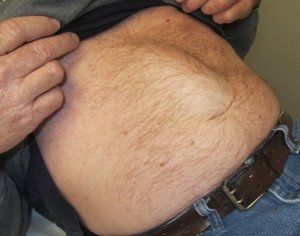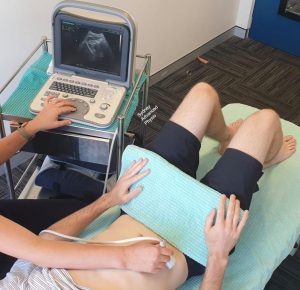Why Do Men Get Abdominal Separation And Why Does It Lead To Back Pain?
 Abdominal separation is an issue that’s usually thought of as something that happens to women after their abdominal wall has been stretched by carrying a child but it is something we see in people who have not carried children. It is possible, and not uncommon, to find smaller degrees of abdominal separation in young, fit, healthy men, for example. It is also common to find more significant separations in men who are perhaps less active. Keep reading to learn what an abdominal separation is, how it happens, what it means for your body and what you can do about it.
Abdominal separation is an issue that’s usually thought of as something that happens to women after their abdominal wall has been stretched by carrying a child but it is something we see in people who have not carried children. It is possible, and not uncommon, to find smaller degrees of abdominal separation in young, fit, healthy men, for example. It is also common to find more significant separations in men who are perhaps less active. Keep reading to learn what an abdominal separation is, how it happens, what it means for your body and what you can do about it.
What is abdominal separation?
If you think of your six-pack muscles – your rectus abdominus – the tissue that runs down the center divides the right side from the left side is called the linea alba. Normally there is about a finger width of space between the right three-pack and the left three-pack and that center divide, the linea alba, is so firm most people don’t even know it’s there.

An abdominal separation happens with the space that runs down the middle gets wider. The linea alba gets stretched wider and there is increased space between the right and left sides of your rectus abdominus.
In all genders our physios have seen this separation range from two finger widths apart to being so wide the therapist can put
their entire hand in the space. It’s common postnatally but it can also be seen in people who haven’t carried children. For example, Alexander Skarsgard can be seen in the Tarzan posters with an increased inter-recti distance (i.e. an abdominal separation). Even though his abs may look enviable
, this separation can contribute to back pain.
Separations can also be seen in people who are not as fit as Skarsgard was when he was playing Tarzan.
What causes abdominal separation?
Every persons situation is different but some common causes include:
- Significant abdominal wall stretch e.g. pregnancy
- Poor core strength
- Muscle imbalances

- Poor coordination of abdominal muscles (i.e. inefficient strategies in how you use your tummy muscles)
- Reduced fitness
- Excessive focus on abdominal muscles in exercise – particularly with increased oblique bias in training programmes.
- Altered breathing strategies
- Restrictions within the ribcage and/or diaphragm.
- Bracing strategies (e.g. when you go to do a heavier movement and you push your belly out)
What does it mean if I have an abdominal separation?
Again, every persons situation is different, and the degree that an abdominal separation impacts them varies BUT it significantly increases the risk of back and pelvic pain, break down of spinal discs, development of hernias, deterioration of continence mechanisms… basically if not managed properly abdominal separations can lead to disc issues in your back, hernias and in women commonly contribute to the leaking of urine during exercise.
It also can impact the way your stomach looks. Lots of men complain of feeling barrel-chested or larger in the stomach than they feel they should be.
What do adbominal separations mean I have an increased risk of back pain?
If you were to do a little sit up or a crunch your the tissue that runs down the middle of your six-pack, the linea alba, should feel firm – like a t-shirt pulled tight – when you touch it. Commonly because there is a core muscle imbalance associated with an abdominal separation, when people do this little sit up or crunch the middle feels softer than it should. Sometimes it’s quite squishy and you can barely feel it.
The linea alba is really important to help transfer force around your body.
If you were to play tennis, for example, and you went to hit the ball, you need the forces generated in your legs and torso to transfer well through your body so you’re not just creating the power in your shot from your arm and shoulder muscles. If your core isn’t great and your linea alba is softer than it should be those forces will travel up your legs, heading up to try and help you hit the tennis ball, but instead of traveling across your body through your stomach muscles it just stops. When it stops that load and force gets dispersed to the lower back and the pelvis. In other words your lower back and pelvis cop all the load because your stomach muscles aren’t working properly. This happens throughout the day with big tasks and small tasks and slowly your joints and discs start to complain.
If your stomach muscles aren’t coordinated and strong this also leaves your back vulnerable.
How do I check if I have abdominal separation?
If you do a little sit-up or a crunch does anything push out the middle where your six-pack should keep things flatter?
If you do a little sit up of a crunch and you gently feel your stomach is there a gap in the middle where there should be muscle?
The best course of action is to get an expert physio like those at Sydney Advanced Physio to check it for you. Roughly 50% of the time patients don’t realise they have an abdominal separation even if it’s quite large because they’re unsure of what to look or feel for. So if you have back pain we would suggest that you get an awesome physio to do a thorough check for you.
How can physios help with this issue?
 Step one is to work out if there are any alignment issues that are impacting how your stomach muscles are working. For example, the nerves that supply your stomach muscles come out of your rib cage so if something funky is happening in the rib cage it might be upsetting the balance in your stomach muscles. This might be as simple as your middle back being a bit stiff.
Step one is to work out if there are any alignment issues that are impacting how your stomach muscles are working. For example, the nerves that supply your stomach muscles come out of your rib cage so if something funky is happening in the rib cage it might be upsetting the balance in your stomach muscles. This might be as simple as your middle back being a bit stiff.
Step two is to assess the pressure balance between your rib cage (thoracic cavity), your belly (abdominal cavity) and your pelvis (pelvic cavity). The balance of pressure needs to be right between these three cavities for everything to function well. Something we commonly see is a weak or tight diaphragm (or both) that is impacting the way someone breaths but also puts more downwards pressure on the belly. If the stomach muscles are weaker then you can get a prominent belly that doesn’t necessarily have anything to do with your weight. It’s a little bit like looking permanently bloated. This means there’s a constant chronic stretching pressure on your abdominal wall.
Step three is to address the way you use your stomach muscles. At Sydney Advanced Physio we have an imaging ultrasound that lets us have a look inside your stomach and have a look at what your muscles are doing when you try and turn them on. This lets us find the best cue for your core muscles and helps you get the muscles turning on in the right order. When this happens the core muscles pull the linea alba tight – remember we want the linea alba to feel like a t-shirt pulled tight.
Once the muscles are turning on in the right order step four is to get you to do some exercises that load the linea alba. If you can get this balance right the loading exercises then help this tissue thicken and get stronger. This helps it transfer forces around your body so you stop overloading your back.
It sounds like a lot but very commonly we can start on step four by the end of your first assessment at Sydney Advanced Physio – this is why we like to spend an hour with you when you first come in.
We hope this information has helped answer questions you might have about why you can see abdominal separation in men and why it can lead to back pain. If you have any questions please don’t hesitate to get in touch.
Leave a reply
